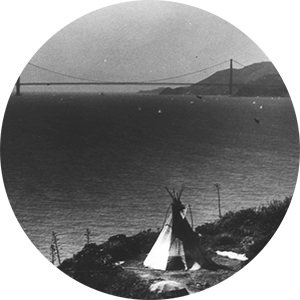Native Hubs
Hello Deep Readers,
Welcome to week four of the Deep Read. If you need to, you can still catch up on week one, two, and three. So far, we’ve had two great salons—our final one is tonight with the members of the Amah Mutsun Tribal Band. Next week, we culminate our exploration of There There with a public conversation with Tommy Orange. RSVP today if you haven’t already done so.
Please keep the comments coming. About the novel’s ability to drive political change, Deep Reader Elena Broslovsky wrote: “I believe the empathy created for these characters leads the reader to a deeper understanding of Native experience …This empathy can create advocates for restorative justice.”
It has been inspiring to see all of the feedback, reflections, and interpretations in our community conversations.

Hubs and Hope
This week, we present a Q&A with Renya Ramirez, a Native American Studies scholar who teaches in the Anthropology department at UC Santa Cruz. A scholar of Bay Area Native history and culture, Prof. Ramirez grew up in the Bay Area and has a direct connection to much of the culture and history depicted in the novel. She is a member of the Winnebago Tribe of Nebraska.
Deep Read: Could you tell us a bit about your scholarly work and background?
Renya Ramirez: My mother was on Alcatraz during the occupation, and she was involved in the beginning of the establishment of Native American Studies at San Francisco State, San Jose State, and Hayward State. I went to graduate school to follow in her footsteps, to expand the project of Native American Studies. I understood this work as an important, decolonial place of empowerment. I wanted to be part of that. So, for me, there’s an activist part of what I do as an academic. My first book—Native Hubs: Culture, Community, and Belonging in Silicon Valley and Beyond—is about urban Native Americans, and it is a scholarly book deeply informed by activism.
Deep Read: How do you see your work intersecting with There There?
Renya Ramirez: The concept of the Native hub is very evident in the novel. The term comes from Laverne Roberts who is Paiute. She explains that the urban area is like the center of a wheel. Emanating from the wheel are spokes that correlate to reservations, pueblos, and other areas and spaces of Native community. The way that Native people connect are various—through trips back and forth from the city to the reservation, through phone calls, and through reading tribal newspapers in the city. Basically, the idea of the Native hub is the way that Native people create culture, community, identity, and belonging when they don’t have a land base. It’s really a diasporic idea. Roberts created oral history sessions around the concept of the Native hub, because she knew there was a division in the Native community around people who were federally recognized and people who were not recognized, such as California Natives.
Tommy Orange does this, too. He creates a larger story of the novel with all of these characters telling their individual stories. It’s like a web, which is similar to the hub, and there’s the complementary image of the spider that runs through the whole book as well. The stories are all connected through these motifs of webs and the spiders. As I read the novel, I kept asking myself, when he depicts these motifs, is he really trying to talk about how urban Native people are dealing with colonialism?
Deep Read: Could you elaborate on the concept of colonialism?
Renya Ramirez: I mainly use the term “settler colonialism” in my work, which is a concept that has gained prominence within the last ten years. At its most basic level, the goal of settler colonialism is the elimination of Native people. And the central issue is land, or occupying and taking over Native land. It’s all about trying to eliminate Native people, both culturally and physically, in order to secure their land. In the book, different characters have gone through and experienced a process of elimination, whether it’s the Federal Relocation Program aimed at removing Native people from their reservations that Orange discusses in the Prologue or the way that characters, such as Orvil and Edwin, are removed from Native culture and traditions but are trying to reconnect to them. Orange is definitely proceeding from this framework of settler colonialism. Another example is Blue’s first chapter in which she is running away from her husband, Paul. I think that Orange did a good job with this character, especially the way he contextualized her escape. For instance, we have her friend, Geraldine, who picks her up on the side of the road and is upset with her for not calling her for a ride:
“Do you know how many Indian women go missing every year?” Geraldine says.
“Do you?” I say.
“No, but I heard a high number once and the real number’s probably even higher.”
“I saw something too, someone posted about women up in Canada.”
“It’s not just Canada, it’s all over. There’s a secret war on women going on in the world.
Secret even to us. Secret even though we know it,” Geraldine says.
There was also the elderly woman who helped Blue in the Greyhound bathroom, who protected her from her husband who was at the station trying to find her. This discussion about missing and murdered Indigenous women is the context, though, and that’s all part of colonization and trying to eliminate us. I thought he did a really good job bringing this concept of settler colonialism to life.
Deep Read: What’s another example of the hub concept playing out in the novel?
Renya Ramirez: There are these different parts of the hub that come through in the novel. For example, Orvil, the young Native boy who desperately wants to connect to his tribal identity. He puts on the regalia that he finds in his great-Aunt Opal’s closet, and he’s looking at all of these YouTube videos in order to learn Native dance. Well, that fits in the notion of the hub. Basically, Opal wasn’t sharing this very important tribal information with him, but he has a hunger to connect to who he is as a tribal person. But he, and other characters, too, represent ways to connect. You can go to the Indian Center. You can put on Native dress. You can join a drum group—those are all things that are related to the hub. It’s a way to maintain your tribal identity community in an urban area where you’re intermixed with all kinds of groups. I could really relate to that.
Deep Read: Are there parts of the novel that diverge from your understanding of the history or Native experience?

Renya Ramirez: Yes, particularly when he talks about Alcatraz (pictured at left from the National Park Service Archive); he talks about the young kids there and they’re all drinking and running about aimlessly. I had a hard time with that because, you know, what I know from my mother and the stories of her friends that were on Alcatraz, many of them, many Native people became sober on the island. It became a place to connect to their tribal identity, a place for healing. For example, there was a school there, an elementary school, and a health clinic and other services. So, this was one of the moments when, as I was reading the novel, I was getting something very different than what I know from my own family tribal history. I was hoping there could be more healing and more of a focus on the Native women who act in the role of clan mothers. Of course, he’s writing fiction not history, but when I talked to my mom about Alcatraz, the institutions they set up there and the healing that took place there—that’s not the story he’s telling.
In a similar way, I had a hard time with the ending of the novel: the shootout scene and seeing all of these people dying. There was this real darkness at the end. I wanted more healing, which is something that I think, as a native person, we have elements of both. We do have drugs, alcohol, and gangs, but we also have the real beauty that happens in urban Native communities, specifically around healing, which I don’t see in the novel.
Go Deep: Think about Ramirez’s own family connection to Alcatraz and the difference between her family experience of events and the novel. Does hearing a different experience of a section of the novel change your understanding of its overall message? What responsibility does a novel have to tell “the whole truth”? At what point do dramatic decisions outweigh historical specifics in a novel? What is the novelist’s responsibility to the historical truth, especially in a novel that opens with a historical essay about Native identity and experience? Ramirez highlighted her concern about the darkness and death of the ending. What did you think of the way the novel ended. What did the violence represent? What does the ending tell you about the overall message or point of the novel?

Join the community conversation: We encourage you to think through these questions as you read and share your thoughts in the comments below
Community Conversation
Share your thoughts, reactions, and ideas with the Deep Read Community. Please note, comments are moderated and won’t populate immediately. Send any questions to deepread@ucsc.edu.

